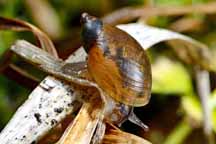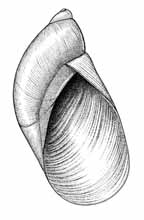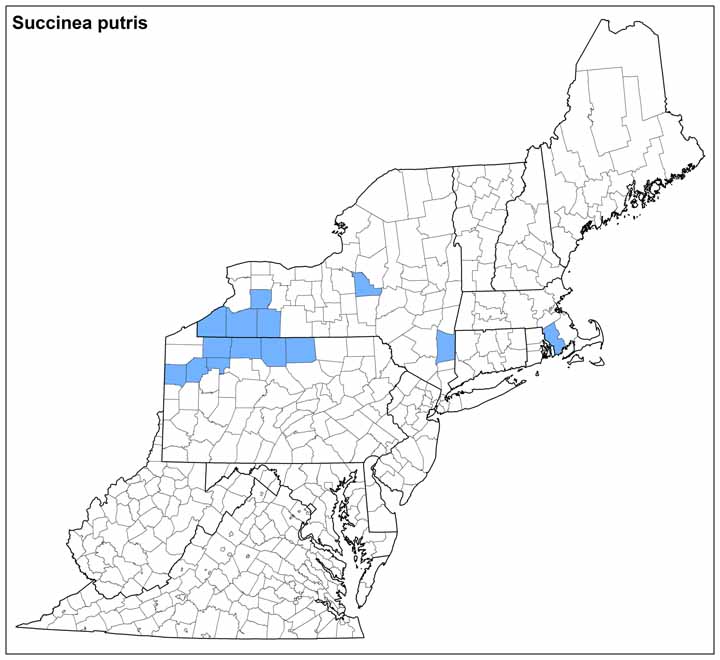Land Snails

Photo(s): Note the relatively shallow suture of the body whorl of Succinea putris in this photo © Roy Anderson

Illustration © Kathy Schmidt from her "Land Snails of New York State" series
Click photos to enlarge.
Succinea putris (Linnaeus, 1758) (non-native)
Family: Succineidae
Common name: European Ambersnail
Identification
Height: ~10-17 mm
Whorls: ~2.8-4.0
The shell of this animal is fragile and elongate, with a large aperture (Kerney and Cameron, 1979). The spire is well less than half the shell height. The shell suture is relatively shallow, and the shell is translucent yellowish or grayish. The animal is gray or cream-colored with gray antennae.
Distinguishing the cryptic shells of this genus can be problematic. Succinea putris has a narrower, sleeker form and flatter final whorl than the North American native Novisuccinea ovalis (Say, 1817).
Ecology
Succinea putris is a wetland snail of Europe and Siberia, often common around ponds, swamps, wet meadows, streams, and irrigation systems. It is an explosive breeder, and at high densities can be a pest of ornamental plants (Hotopp, pers. obs.).
In Poland, S. putris reproduced from May to September with early and late peaks, and snails grew fastest in June-October (Kuźnik-Kowalska et al., 2013). Eggs were laid in clusters of 5-64, and hatched in 11-28 days. Snails matured in approximately 160 days, at about 3.0 whorls in size. Lifespan was 210-420 days (7-14 months), suggesting a semelparous (single mating bout) lifecycle. However, the authors warn of wide local variation in life history. In Lithuania, S. putris brought into the laboratory lived 13-17 months, but likely longer in the wild (Ðatkauskienë, 2005). In the field, S. putris laid an average of 48 ±12 eggs. Overwintering snails were mostly juveniles.
In Europe Succinea putris is an important intermediate host of Elaphostrongylus cervi, one of the parasites that causes cervid brainworm disease in caribou, elk, and moose (e.g. Kuligowska, 2009). However, this parasite does not appear to be transmitted to non-cervid hosts as can happen with the related Parelaphostrongylus tenuis (Mason, 1989). Succinea putrisis also a host of trematodes (e.g. Ataev et al., 2016).
Taxonomy
Succinea putris is part of a family whose taxonomy is not well understood. Looking at allozymes and internal anatomy of putative S. putris in western New York, Hoagland and Davis (1987) distinguished an undescribed cryptic species and suggest that S. putris is a species complex.
The species has also been known as Helix putris and Succinea amphibia.
Distribution
This ambersnail appears to be widely introduced in parts of the Northeast Region, though distinguishing succineids by shell shape can be confusing. It appears to be common in the farmlands of central New York State, and along the coast and in nurseries in Maine (Hotopp, pers. obs.), though museum specimen records are patchy.
Conservation
NatureServe Rank: G5, Secure.
The European Succinea putris, perhaps a species complex, appears to be rapidly expanding its range in some agricultural and coastal areas in the Northeast Region.
Ken Hotopp 12/2017
Range Map (click to enlarge)


